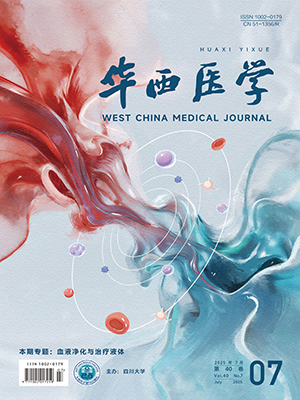| 1. |
中华医学会骨科学分会创伤骨科学组, 中国医师协会骨科医师分会创伤专家工作委员会. 成人股骨颈骨折诊治指南. 中华创伤骨科杂志, 2018, 20(11): 921-928.
|
| 2. |
Johnell O, Kanis JA. An estimate of the worldwide prevalence and disability associated with osteoporotic fractures. Osteoporos Int, 2006, 17(12): 1726-1733.
|
| 3. |
张浩. 青壮年股骨颈骨折的内固定手术治疗进展. 沈阳医学院学报, 2021, 23(2): 182-185.
|
| 4. |
徐凯航, 纪方. 青壮年股骨颈骨折的治疗进展. 中华创伤骨科杂志, 2020, 22(6): 549-552.
|
| 5. |
陈志兵, 王光林, 林佳生, 等. 空心螺钉与动力髋螺钉加防旋螺钉治疗股骨颈骨折疗效比较. 中国修复重建外科杂志, 2011, 25(1): 26-29.
|
| 6. |
Slobogean GP, Sprague SA, Scott T, et al. Complications following young femoral neck fractures. Injury, 2015, 46(3): 484-491.
|
| 7. |
范克杰, 陈柯, 田可为, 等. 手法闭合复位联合平行螺钉和偏轴螺钉内固定治疗青壮年垂直不稳定型股骨颈骨折. 中医正骨, 2020, 32(7): 47-50,54.
|
| 8. |
Fan Z, Huang Y, Su H, et al. How to choose the suitable FNS specification in young patients with femoral neck fracture: a finite element analysis. Injury, 2021, 52(8): 2116-2125.
|
| 9. |
Li L, Zhao X, Yang X, et al. Dynamic hip screws versus cannulated screws for femoral neck fractures: a systematic review and meta-analysis. J Orthop Surg Res, 2020, 15(1): 352.
|
| 10. |
Siavashi B, Aalirezaei A, Moosavi M, et al. A comparative study between multiple cannulated screws and dynamic hip screw for fixation of femoral neck fracture in adults. Int Orthop, 2015, 39(10): 2069-2071.
|
| 11. |
Bonnaire FA, Weber AT. Analysis of fracture gap changes, dynamic and static stability of different osteosynthetic procedures in the femoral neck. Injury, 2002, 33(Suppl 3): C24-C32.
|
| 12. |
江辉耀. 动力髋螺钉联合防旋螺钉和空心加压螺钉治疗股骨颈骨折的疗效比较. 中国医药科学, 2013(23): 210-212.
|
| 13. |
Giordano V, Giordano M, Aquino R, et al. How do orthopedic surgeons manage displaced femoral neck fracture in the middle-aged patient? Brazilian survey of 78 orthopaedic surgeons. Rev Bras Ortop (Sao Paulo), 2019, 54(3): 288-294.
|
| 14. |
曾宪涛, 庄丽萍, 杨宗国, 等. Meta 分析系列之七: 非随机实验性研究、诊断性试验及动物实验的质量评价工具. 中国循证心血管医学杂志, 2012, 4(6): 496-499.
|
| 15. |
Slim K, Nini E, Forestier D, et al. Methodological Index For Non-Randomized Studies (MINORS): development and validation of a new instrument. ANZ J Surg, 2003, 73(9): 712-716.
|
| 16. |
刘粤, 郑士伟, 刘树义, 等. 三枚空心钉与动力髋螺钉结合空心钉治疗青壮年股骨颈骨折的比较研究. 中国修复重建外科杂志, 2010, 24(9): 1149-1150.
|
| 17. |
李炜. 空心螺钉与动力髋螺钉加防旋螺钉治疗股骨颈骨折疗效比较. 中国现代医生, 2012, 50(16): 36-38.
|
| 18. |
邓宾, 胡栢均, 林志炯, 高大伟. 2 种内固定方式治疗头颈型股骨颈骨折的比较. 新中医, 2013, 45(7): 51-52.
|
| 19. |
梁西兴, 赵莉. 空心加压螺钉治疗股骨颈骨折 60 例临床分析. 当代医学, 2014(22): 23-24.
|
| 20. |
杨建军. 不同类型内固定方法治疗股骨颈骨折的临床对比分析. 中外健康文摘, 2014(23): 97-98.
|
| 21. |
赵喜东. 空心加压螺钉治疗股骨颈骨折疗效分析. 大家健康(中旬版), 2014(12): 124.
|
| 22. |
高悠水, 陈松, 周祖彬, 等. Pauwels 3 型股骨颈骨折的手术治疗 46 例分析. 中国骨与关节杂志, 2015(2): 96-100.
|
| 23. |
侯吴仁, 徐敏鸥. 动力髋螺钉加防旋螺钉与 3 枚空心螺钉治疗股骨颈粉碎性骨折的疗效比较. 中国骨伤, 2015, 28(9): 796-801.
|
| 24. |
吴石华, 王朝晖, 张静. Pauwels Ⅲ型股骨颈骨折空心螺钉与动力髋螺钉固定效果分析. 东方食疗与保健, 2015, 1(1): 18-19.
|
| 25. |
Zhang YL, Chen S, Ai ZS, et al. Osteonecrosis of the femoral head, nonunion and potential risk factors in Pauwels grade-3 femoral neck fractures: a retrospective cohort study. Medicine (Baltimore), 2016, 95(24): e3706.
|
| 26. |
王齐, 韩国建, 张宇, 等. 两种手术方法治疗 PauwelsⅢ型股骨颈骨折的临床效果分析. 中华骨与关节外科杂志, 2016, 9(5): 414-417.
|
| 27. |
崔巍, 简争光, 孙雪峰, 等. DHS 结合中空加压螺钉治疗股骨颈骨折 30 例临床效果分析. 中国医药指南, 2016, 14(35): 103-104.
|
| 28. |
郭文彤. 动力髋螺钉联合防旋螺钉对股骨颈骨折患者术后并发症及功能恢复的临床观察. 泰山医学院学报, 2016, 37(12): 1389-1390.
|
| 29. |
尹广政. 空心钉与动力髋螺钉加防旋螺钉内固定治疗股骨颈骨折的疗效比较. 中国骨与关节损伤杂志, 2016, 31(6): 28-29.
|
| 30. |
屈铁男. DHS 结合中空加压螺钉治疗股骨颈骨折 60 例的临床效果分析. 三峡大学学报(自然科学版), 2017, 39: 129-131.
|
| 31. |
饶汉荣, 陈骏钦. 股骨颈骨折空心钉与动力髋螺钉加防旋钉内固定的临床对比研究. 内蒙古医学杂志, 2018, 50(7): 826-827.
|
| 32. |
汪波. 动力髋螺钉联合防旋螺钉内固定对股骨颈骨折术后髋关节功能的影响. 内蒙古医学杂志, 2018, 50(8): 979-981.
|
| 33. |
Sharma A, Sethi A, Sharma S. Comparative analysis of treatment of basicervical femur fractures in young adults with CCS, DHS, and PFN. Rev Bras Ortop, 2018, 53(6): 783-787.
|
| 34. |
Bisaccia M, Ceccarini P, Rinonapoli G, et al. Dhs plus anti-rotational screw vs cannulated screws for femoral neck fractures: an analysis of clinical outcome and incidence regarding avn. Acta Orthop Belg, 2018, 84(3): 279-283.
|
| 35. |
王晓天, 施丽燕. 空心螺钉与动力髋螺钉加防旋螺钉治疗股骨颈骨折疗效比较. 大医生, 2019, 4(16): 94-95.
|
| 36. |
张红岗. 不同术式治疗 PauwelsⅢ型股骨颈骨折患者近期预后比较. 中国药物与临床, 2020, 20(11): 1851-1853.
|
| 37. |
Şahin A, Agar A, Gülabi D, et al. Comparison of dynamic hip screw and antirotation screw with cannulated screw in the treatment of transcervical collum femoris fractures. Jt Dis Relat Surg, 2020, 31(2): 320-327.
|
| 38. |
Dickson JA. The unsolved fracture; a protest against defeatism. J Bone Joint Surg Am, 1953, 35(4): 805-822.
|
| 39. |
Duffin M, Pilson HT. Technologies for young femoral neck fracture fixation. J Orthop Trauma, 2019, 33(Suppl 1): S20-S26.
|
| 40. |
Filipov O. The method of biplane double-supported screw fixation (BDSF) at femoral neck fractures - principle and clinical outcomes. J of IMAB, 2013, 19(1): 423-428.
|
| 41. |
Panteli M, Rodham P, Giannoudis PV. Biomechanical rationale for implant choices in femoral neck fracture fixation in the non-elderly. Injury, 2015, 46(3): 445-452.
|
| 42. |
Baitner AC, Maurer SG, Hickey DG, et al. Vertical shear fractures of the femoral neck. A biomechanical study. Clin Orthop Relat Res, 1999(367): 300-305.
|
| 43. |
Deneka DA, Simonian PT, Stankewich CJ, et al. Biomechanical comparison of internal fixation techniques for the treatment of unstable basicervical femoral neck fractures. J Orthop Trauma, 1997, 11(5): 337-343.
|
| 44. |
Mahomed NN, Arndt DC, McGrory BJ, et al. The Harris hip score: comparison of patient self-report with surgeon assessment. J Arthroplasty, 2001, 16(5): 575-580.
|
| 45. |
Liporace F, Gaines R, Collinge C, et al. Results of internal fixation of Pauwels type-3 vertical femoral neck fractures. J Bone Joint Surg Am, 2008, 90(8): 1654-1659.
|
| 46. |
Zlowodzki M, Jönsson A, Paulke R, et al. Shortening after femoral neck fracture fixation: is there a solution? Clin Orthop Relat Res, 2007, 461: 213-218.
|
| 47. |
Aminian A, Gao F, Fedoriw WW, et al. Vertically oriented femoral neck fractures: mechanical analysis of four fixation techniques. J Orthop Trauma, 2007, 21(8): 544-548.
|




